Peach Preserves
Use summer’s peach bounty to make home made peach preserves with an optional hint of vanilla. You can water bath can, freeze or refrigerate these preserves.
Combining fresh, ripe peaches with sugar produces a delicious and sweet preserve that can be used in various ways, such as spreading it on toast or incorporating it into baking recipes. This recipe includes instructions for water bath canning and freezing homemade peach preserves.
I’m hard-pressed to say ‘this’ is my favorite jam or jelly, but it is in the top two of my favorite sweet preserves if it has apricot and peaches. This very easy peach preserves recipe uses only two ingredients for a very peachy treat.
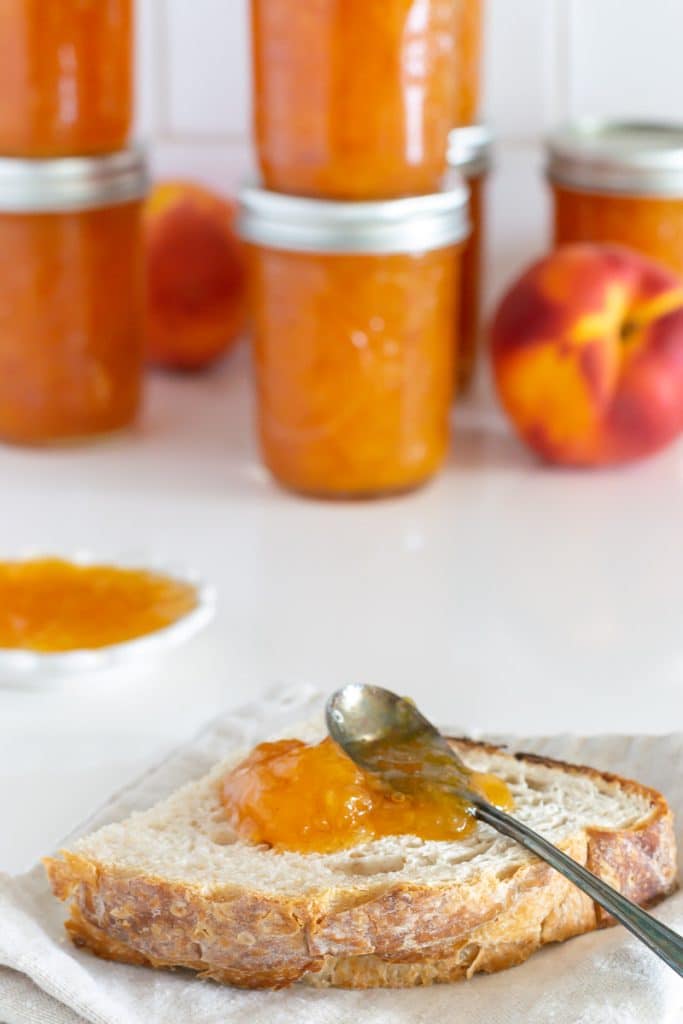
Table of Contents
Why You’ll Love Making Peach Preserves
There are many reasons to love these homemade peach preserves.
- Flavor: First and foremost, the taste is delicious! Fresh, ripe peaches lend a sweet, slightly tart flavor far superior to any store-bought version. The optional addition of vanilla bean pods provides an extra depth of flavor that complements the natural peachiness beautifully.
- Only two ingredients! Peaches and sugar.
- Versatility: These peach preserves are incredibly versatile. They can be spread on toast, filled in pastries, swirled into yogurt, or served alongside savory dishes.
- Long Shelf Life: Following the water bath canning process described in the recipe, these peach preserves can last for two years unopened, allowing you to enjoy the taste of fresh peaches even when they’re out of season. If you freeze your preserves, plan to use them within 6 months.
- Fewer Additives: Unlike many store-bought preserves, when you make your own, you know exactly what’s going into it. There is no high fructose corn syrup or artificial preservatives, just fruit, sugar, or optional vanilla beans.
- Fun and Rewarding: Making preserves is a fun, rewarding process, especially when you see the fruits of your labor (quite literally) lining your pantry shelves. It can be a great family activity too.
- Economical: If you have a peach tree or peaches are in season and on sale at your local market, making preserves is an economical way to use the bounty and avoid waste.
- Gift Giving: Homemade preserves make wonderful gifts. They’re delicious treats handmade by you and can be beautifully packaged with just a little effort. My favorite way to give a jar of jam is to attach a vintage or unique spoon to each jar.
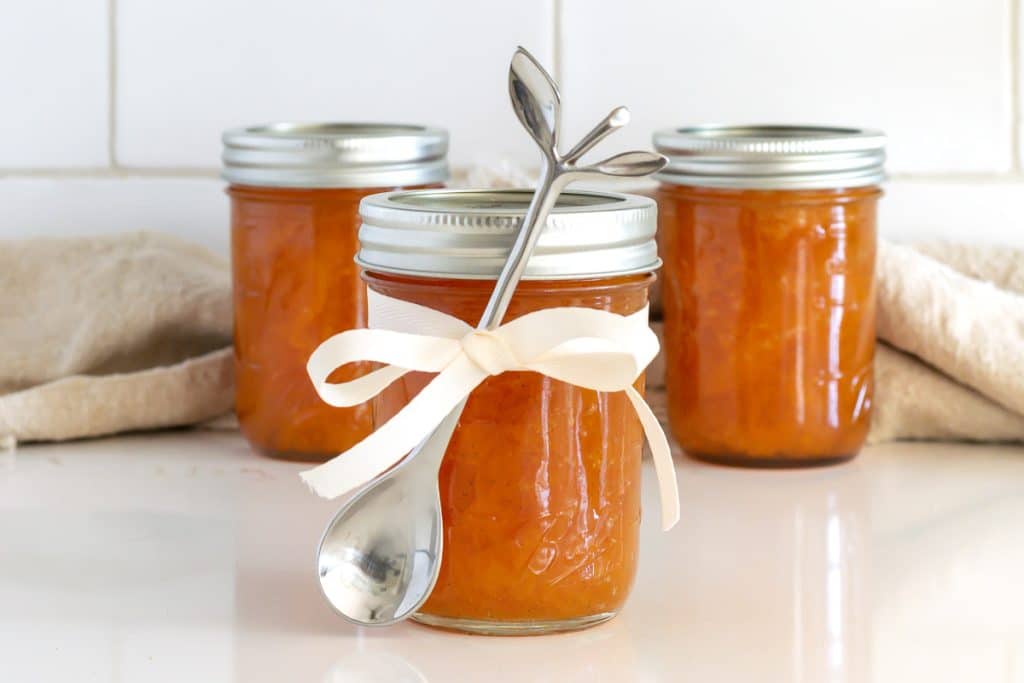
In short, making and enjoying homemade peach preserves is a delightful experience that’s well worth the effort.
Ingredients In This Peach Preserve Recipe
One of the reasons I love this peach preserves recipe is the minimal number of ingredients. Two ingredients! Name another recipe that produces such a delightful treat with just two ingredients…go ahead; I’ll wait.🕝
And those two simple ingredients are peaches and sugar:
Peaches
Choose barely ripe peaches, as they will have more pectin than ripe or overripe peaches. The more pectin in your fruit, the quicker it will reach a gel stage. When making jams, jellies, and preserves, it is always preferable to cook them quickly. This is because the final product will be fresher than fruit that has been cooked for longer periods.
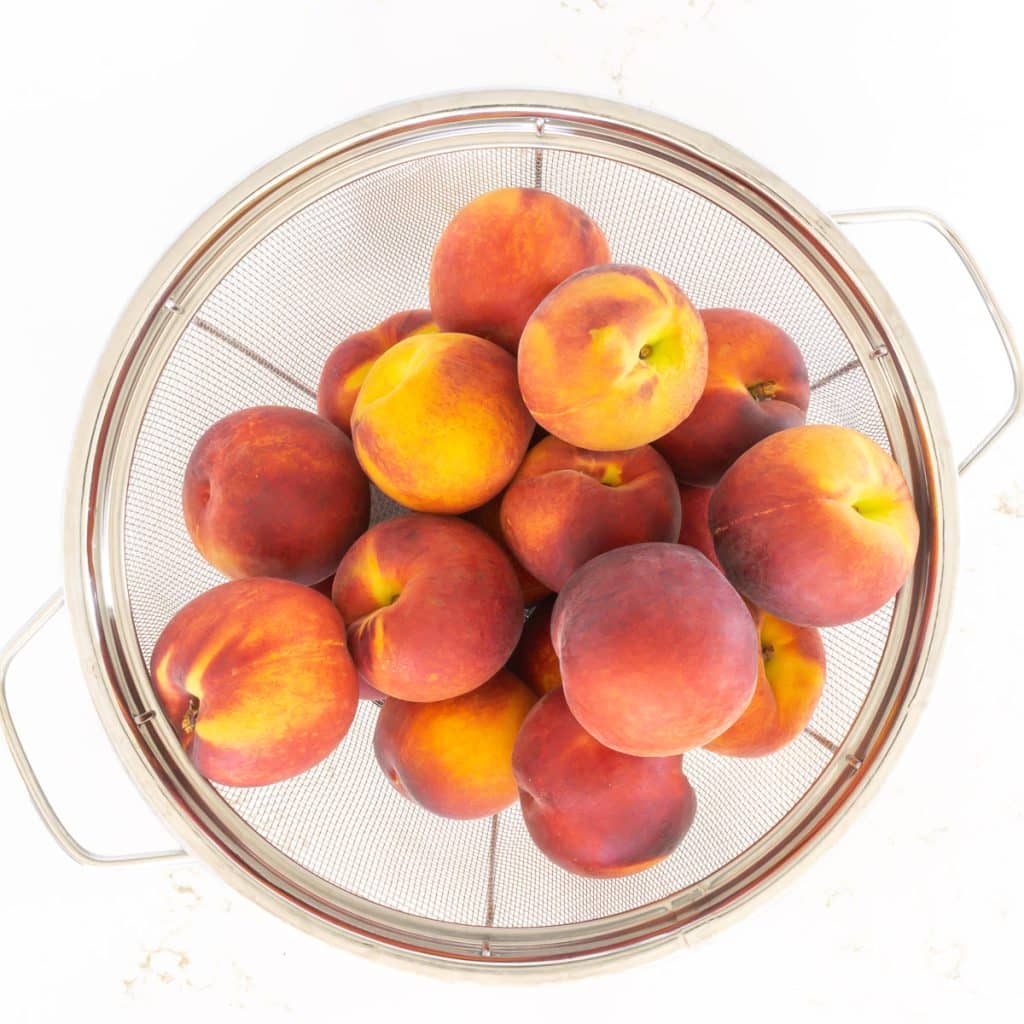
Sugar
Simple, white granulated sugar is all that is needed for this peach preserves recipe.
Vanilla Bean (optional!)
I added two sliced vanilla bean pods to the pot, adding just a hint of aromatic vanilla. Feel free to add more or leave it out altogether. If you want a hint of vanilla, but don’t have pods, substitute two teaspoons of vanilla at the end of cooking the preserves before you tuck them in the jars.
This Jelly + Jam Making Basics 101 article discusses Jam Making Basics, including the main ingredients of jams and jellies, their importance, and the basic equipment for making jams and jellies. Additionally, we discuss the differences between various jellied fruits and vegetables. It’s a great resource for new canners or anyone needing a refresh.
Tips For Successful Peach Preserves
Choosing Peaches: The quality of your preserves largely depends on the fruit you use. Choose just ripe peaches that are free of blemishes. Avoid overly ripe or bruised fruit. Peaches are a highly pesticided fruit; when I can, I try to find organic fruit when making jams, jellies, and preserves.
Peeling Peaches: Peeling peaches can be made easier by blanching them. To do this, cut a small “x” on the bottom of each peach, plunge them into boiling water for about 30-60 seconds, and then quickly transfer them to a bowl of ice water. The skin should slide off easily. This technique works best for riper peaches and less so for underripe peaches.
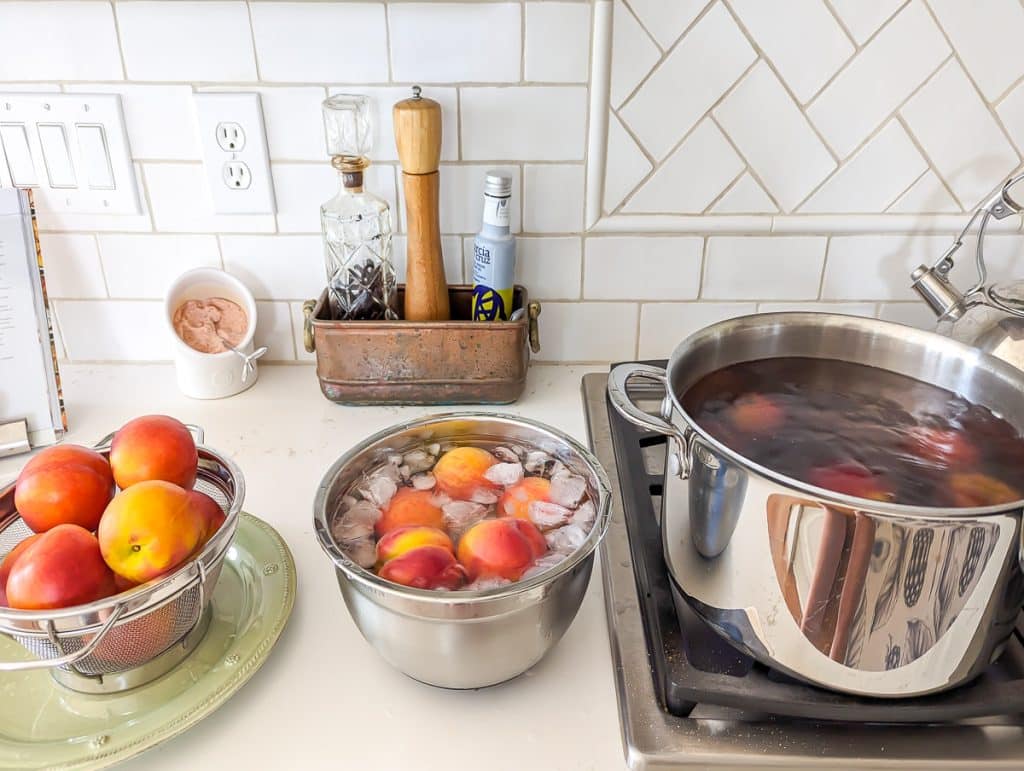
Macerate the Peaches: Maceration means to soften something by soaking it in a liquid. In this case, the liquid is produced by tossing fresh peaches with sugar, as sugar pulls liquids from fruit. At a minimum, macerate your fresh peaches for at least 12 hours. I have let my peaches macerate for up to 48 hours when making this jam.
In effect, we are ‘precooking’ the peaches by macerating them. When we add the peaches to our jam pot, it is already soft, and the juices have already been released. This preserves recipe uses the power of maceration to reduce the cooking time of the peaches.
Use the Best Pot: When cooking your preserves, be sure to use a large, wide-bottomed pot. The distinctive shape of a jam pan or maslin pan (wide and shallow) increases the surface area of the jam or preserves exposed to heat. This allows for quicker evaporation of water, which helps thicken the preserves faster and reduces the cooking time. It also helps prevent overcooking of the fruit.
Stir Frequently: To avoid burning, be sure to stir the preserves frequently, especially as it starts to thicken.
Test for Doneness: Use the frozen plate method to check if your preserves are ready. Spoon a little bit of the preserve onto a chilled plate, then return it to the freezer for a few minutes. If the preserve wrinkles when you nudge it, it’s done. If it’s still runny, continue to cook and test again in a few minutes.
Sterilize Your Jars: Be sure to sterilize your jars and lids before canning. This ensures that your preserves remain safe and free of bacteria.
Leave Proper Headspace: When filling your jars, leave about 1/4 inch of space at the top (this is called ‘headspace’) if water bath canning and 1 inch if freezing. This allows the preserves to expand during the canning process.
Seal Tightly But Not Too Tight: Screw the lids securely, but not overly tight…the term is ‘fingertip tight’. When applying the lid and band, secure them firmly enough to prevent leakage but not so tight that air cannot escape from the jar during processing. Use your fingertips to screw the band down until you meet resistance instead of using your whole hand or additional tools that could overtighten it.
Achieving the correct tightness is important because it allows air to escape from the jars during processing. This is part of the process that creates a vacuum seal as the jars cool. Tightening the bands too much can prevent air from escaping and cause a failed seal or, in some cases, lead to the jars breaking in the canner due to pressure buildup.
Once you have sealed and cooled the jars, remove the screw bands for storage. The vacuum seal that has formed on the lid is what keeps the jar’s contents preserved, not the band.
Store Properly: Store your sealed canned preserves in a cool, dark place after processing. Refrigerate any jars that don’t seal, and always refrigerate after opening.
Remember that making preserves is as much art as it is science. Don’t be disheartened if your first batch isn’t perfect; it will still taste delicious! The more you practice, the better you’ll get.
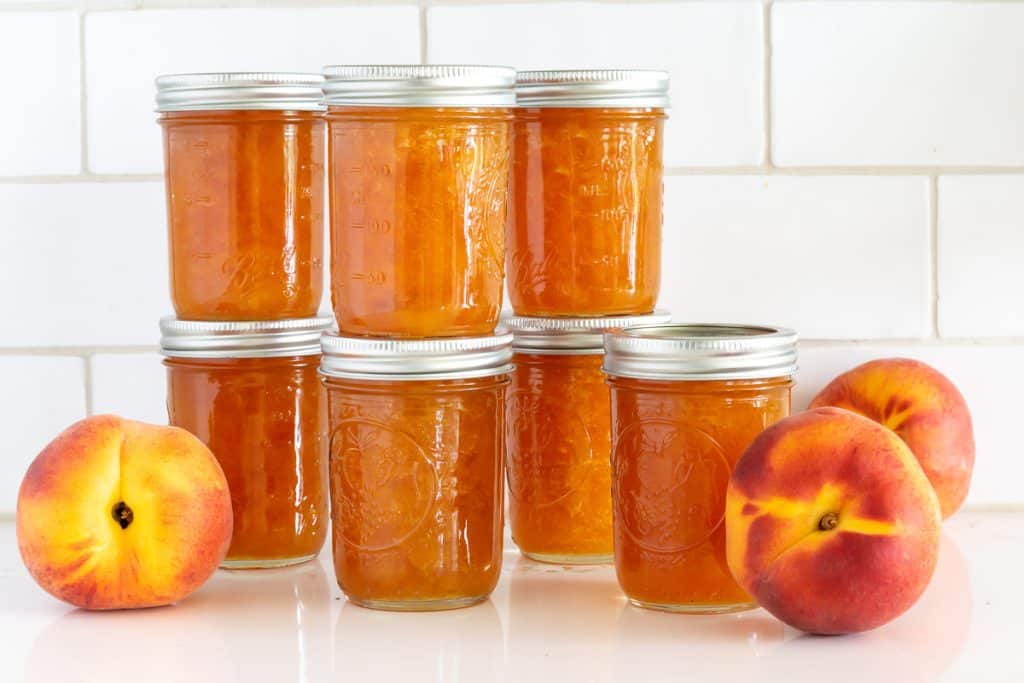
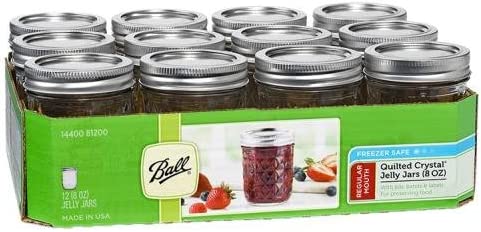
my go-to jelly jars
Ideal for fresh preserving recipes such as jams, jellies, sauces, mustards and flavored vinegar.
Making and Canning Peach Preserves
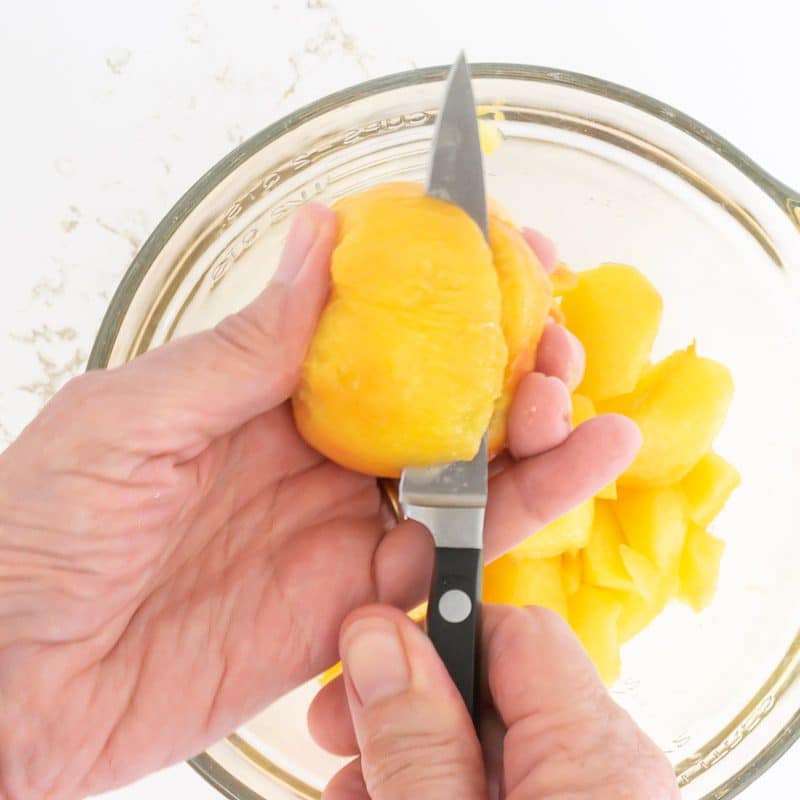
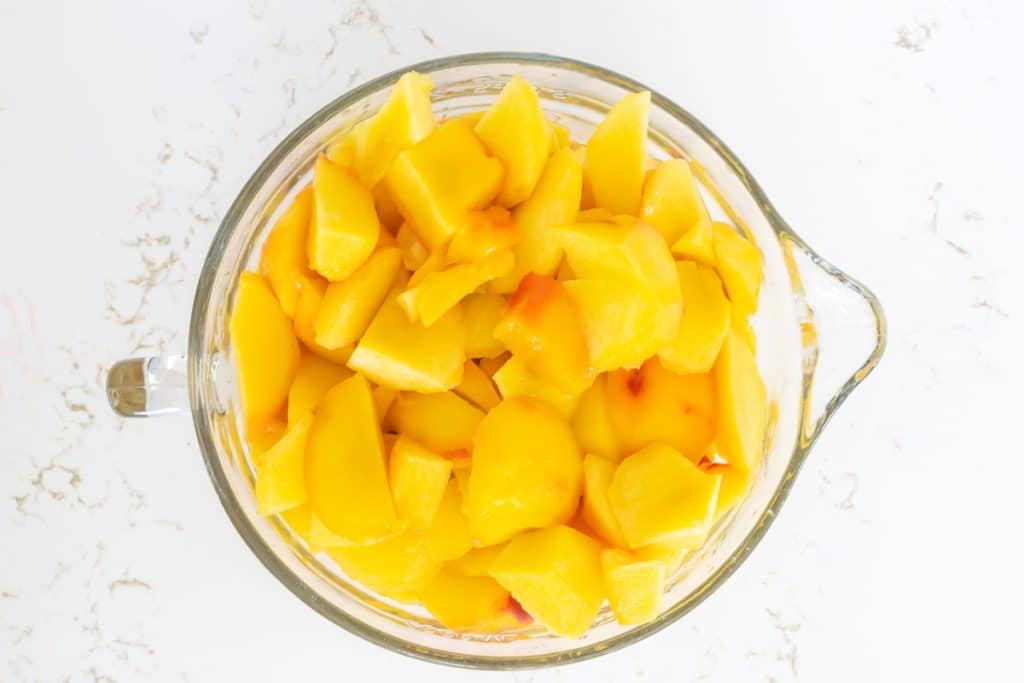
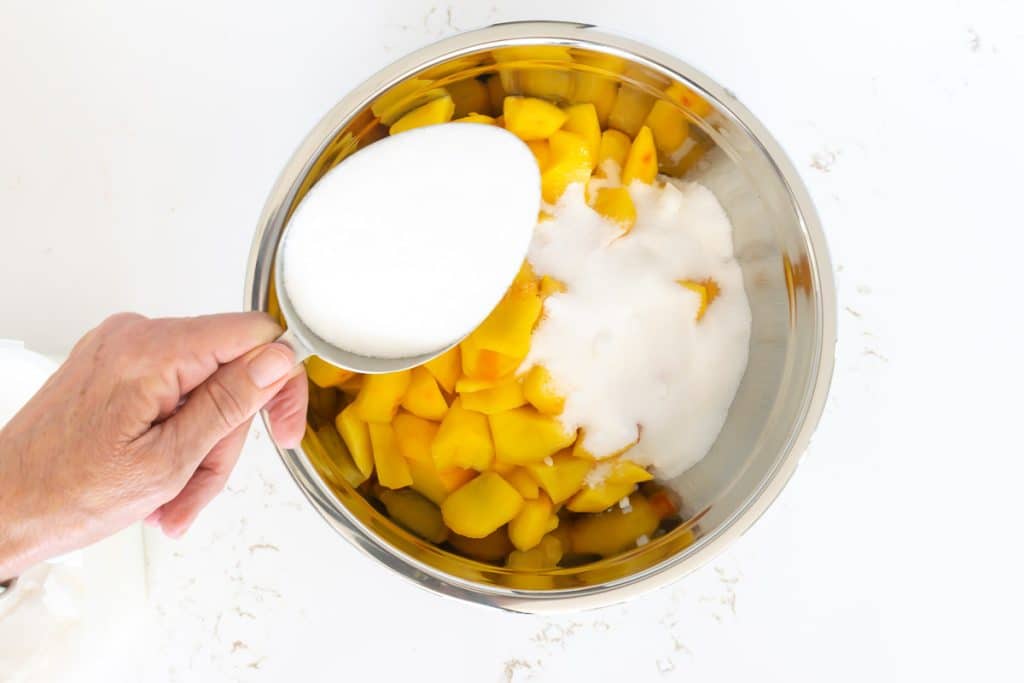
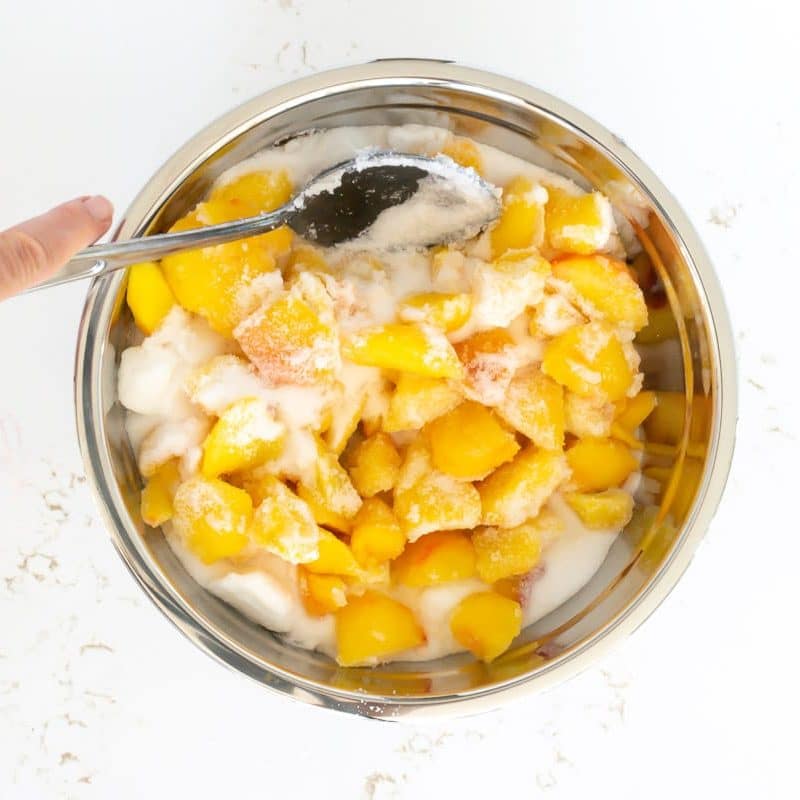
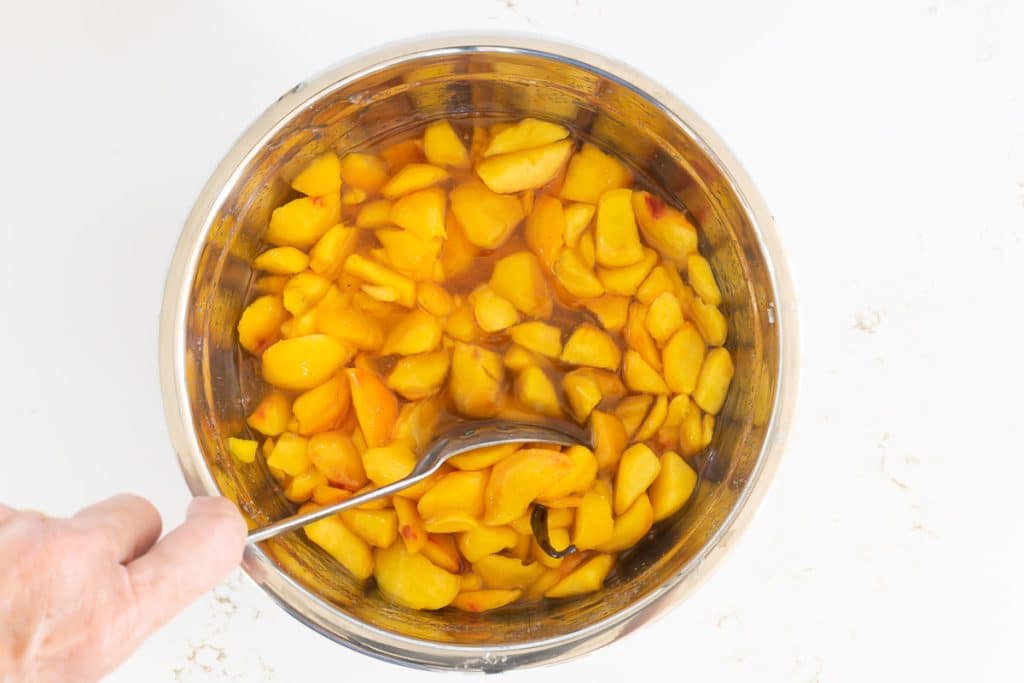
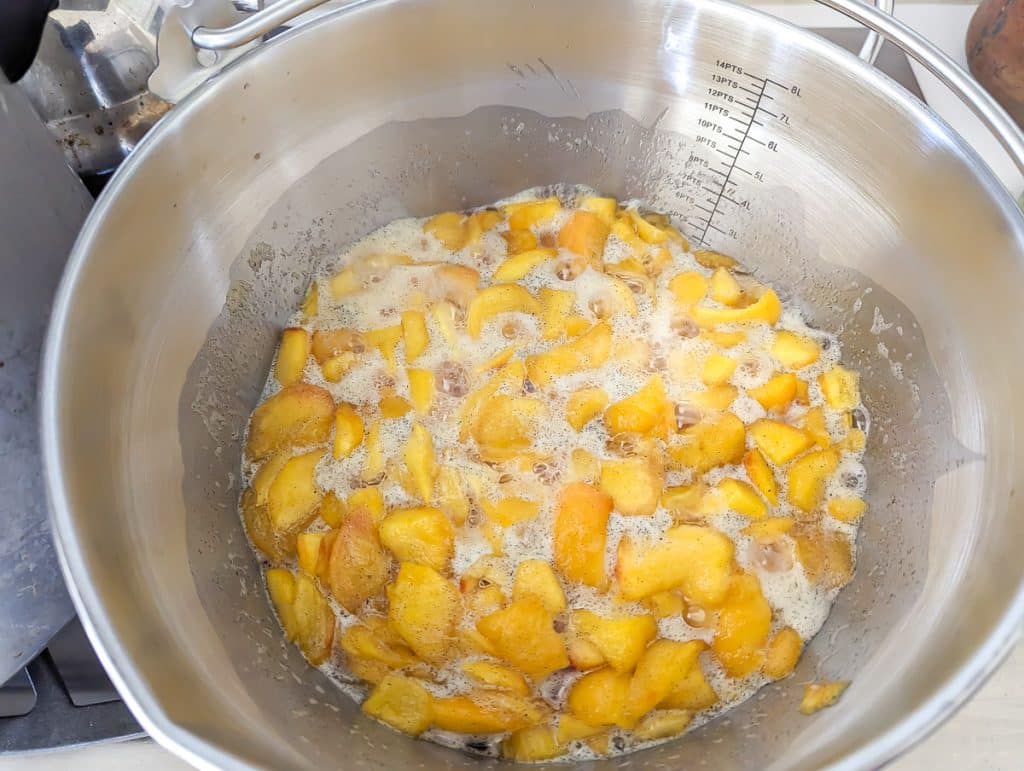
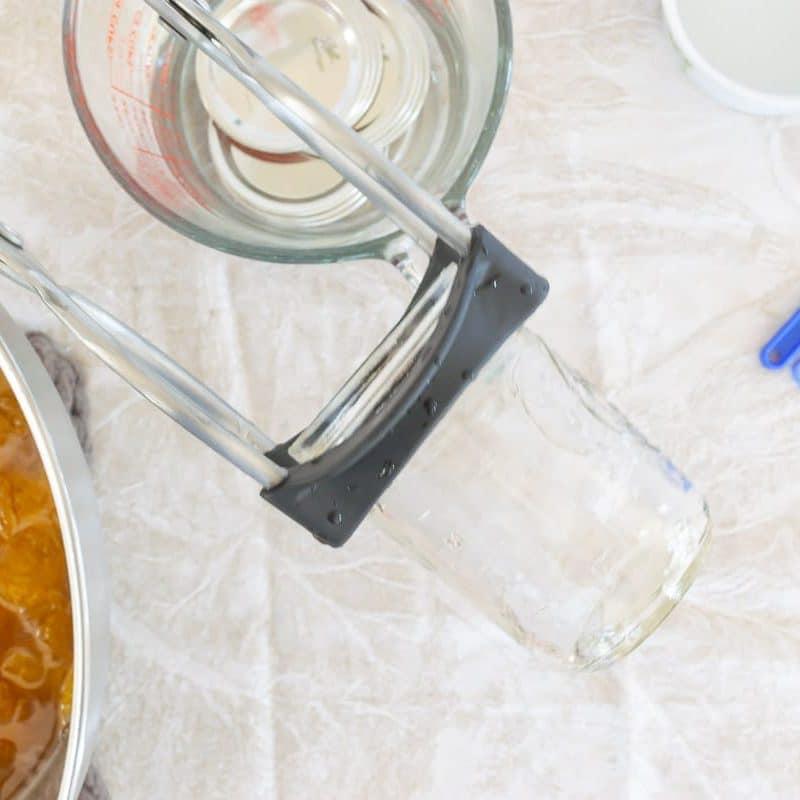
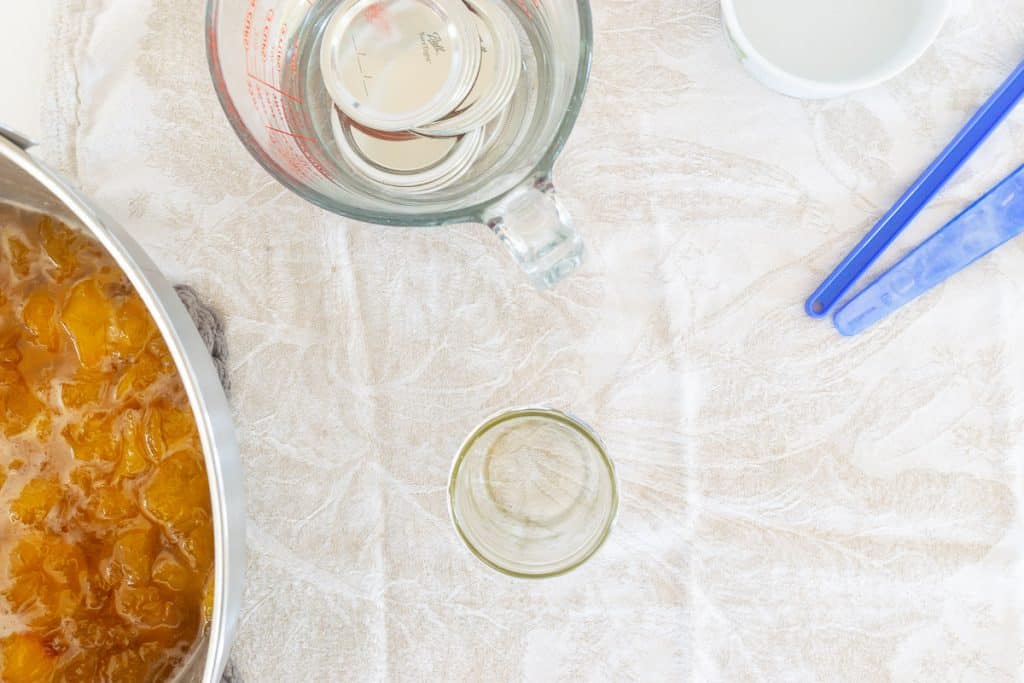
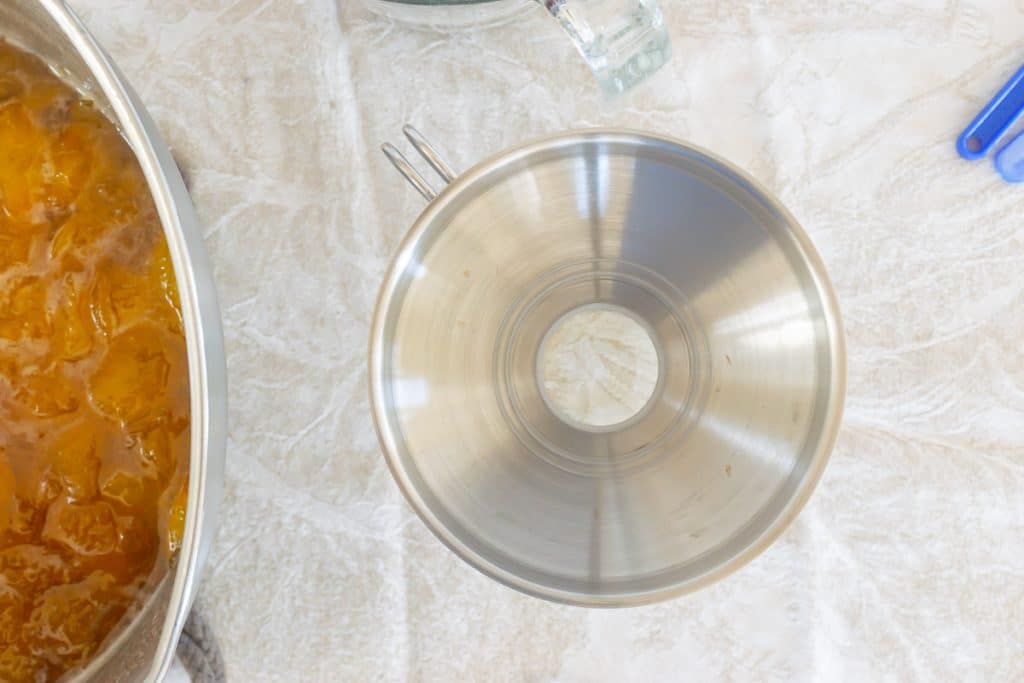
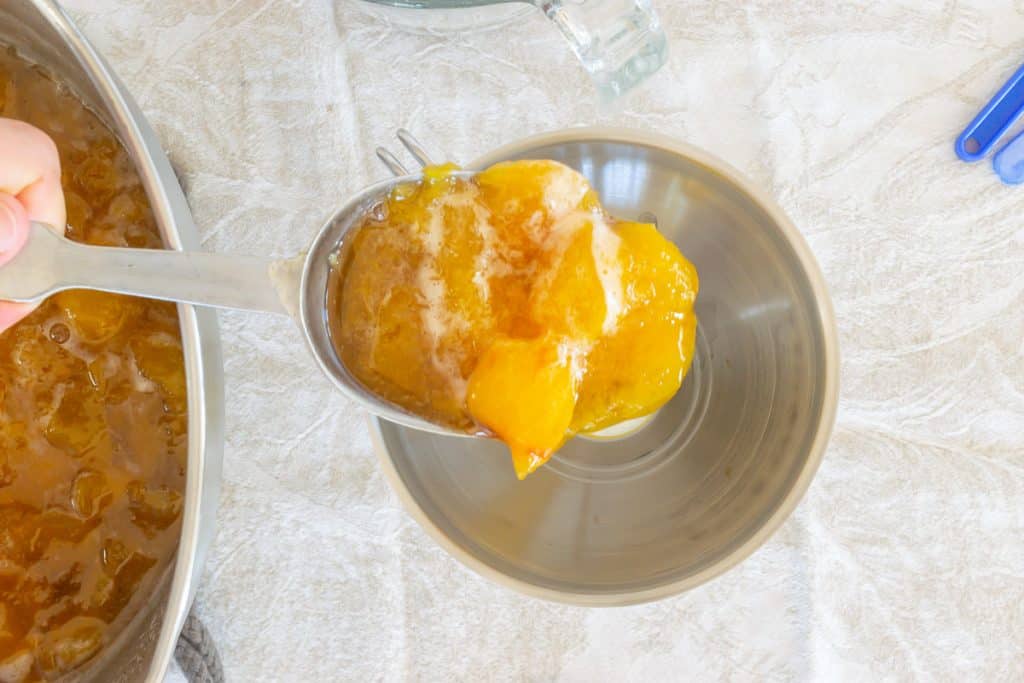
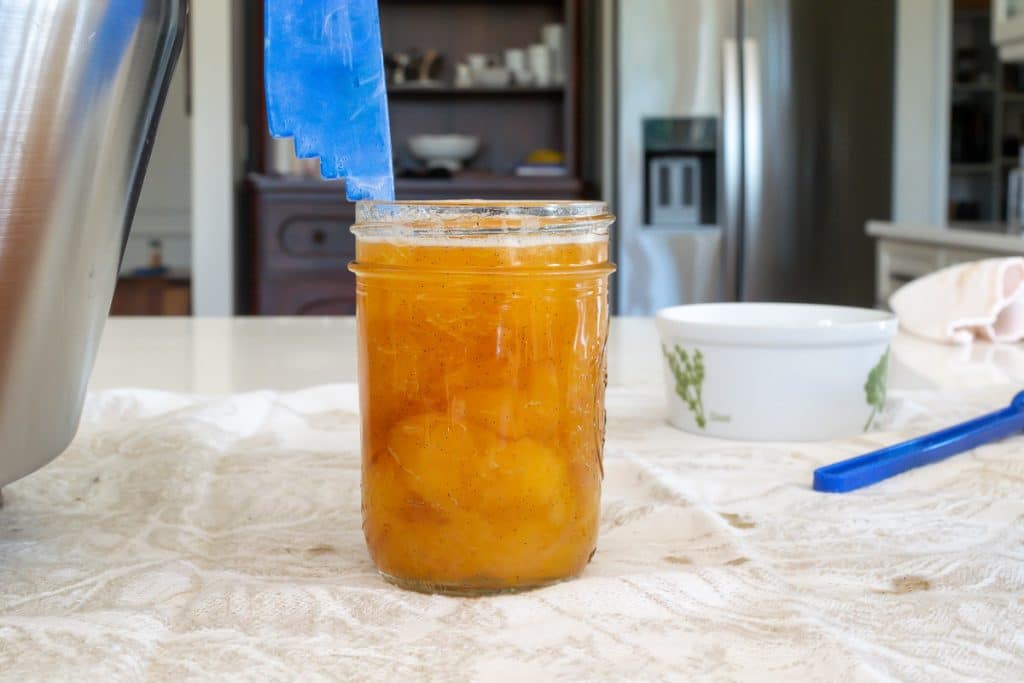
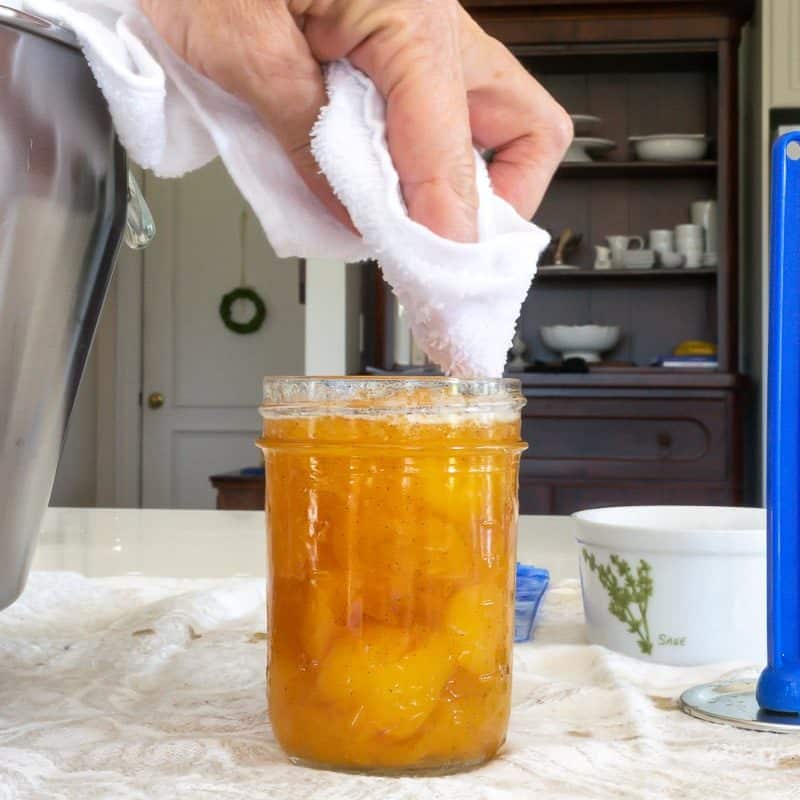
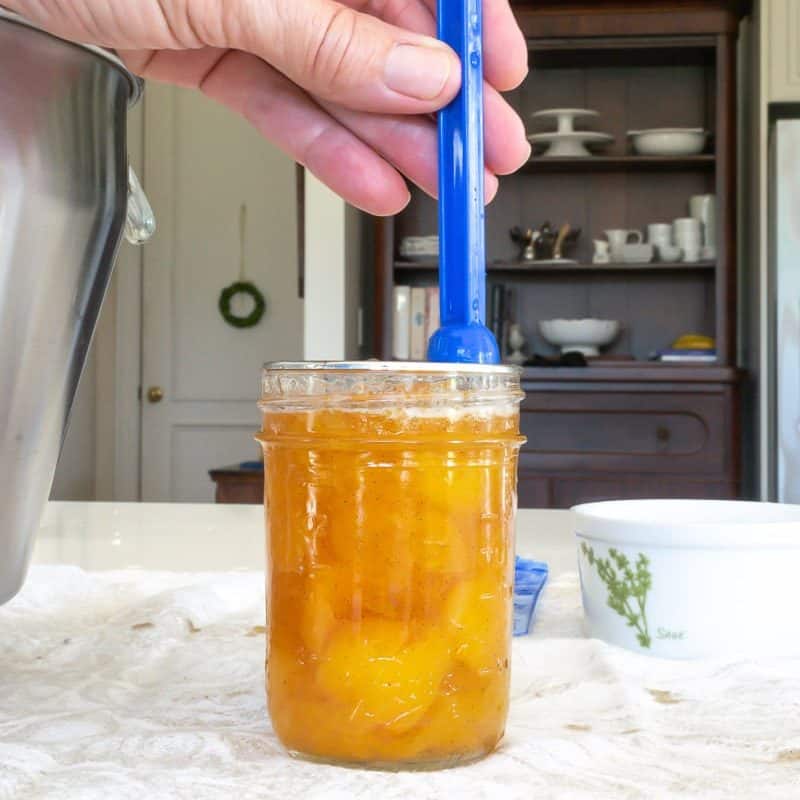
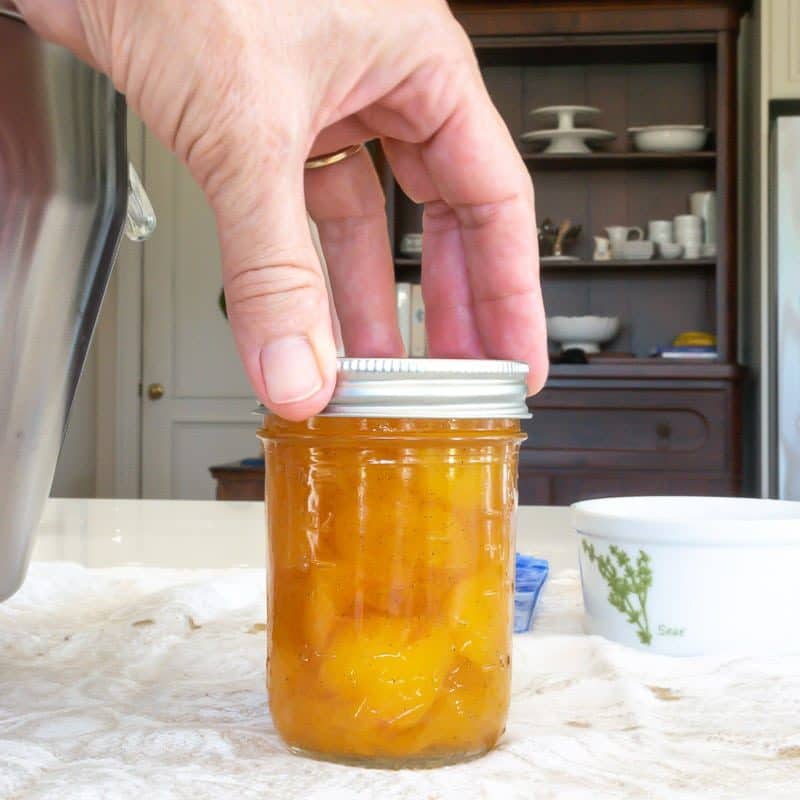
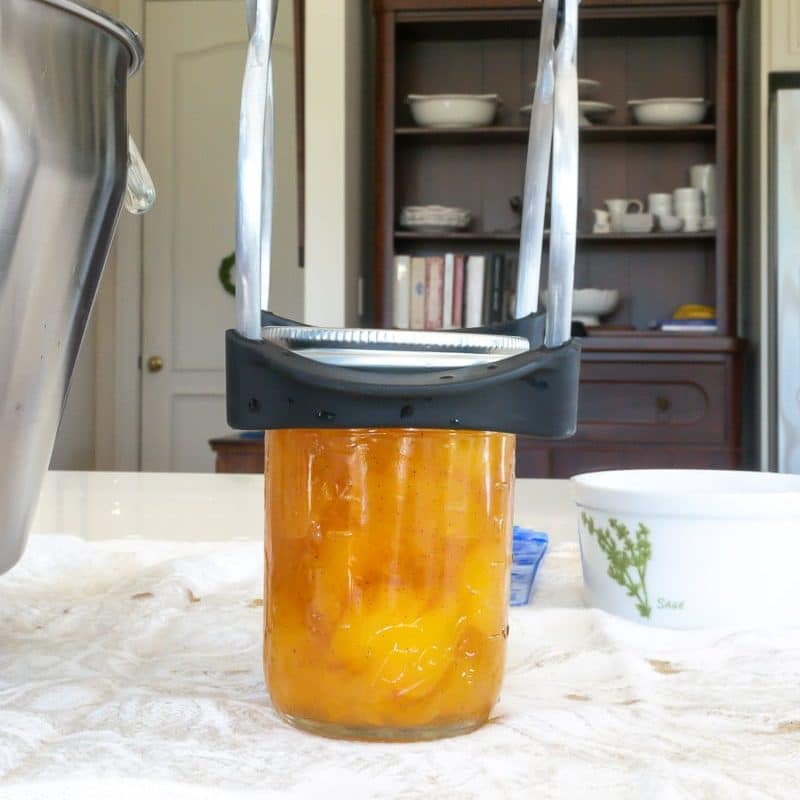
Supplies I Use When Making Jams, Jellies + Preserves
Some of these links may be Amazon affiliate links and I may earn a small commission from the sale of these products to help defray the costs of operating this site, but the price you are charged is not affected. You can see my full disclosure policy here.
While boiling water canning isn’t hard, it does require a few pieces of equipment to make the task much easier:
- A Jam Pan or Maslin Pan
- Jar Lifter
- Magnetic Canning Lid Lifter
- Headspace Gauge
- Ball Jars or Kerr Jars or another suitable canning jar.
- A Wide-Mouth Funnel
- The Ball Complete Book of Home Preserving or The All New Ball Book Of Canning And Preserving.
- A clean surface
- Clean towels
- A large spoon or measuring cup to scoop the jam or preserves into each jar.
- A bowl of white vinegar and a clean dishcloth or paper towels.
The Ball Complete Book of Home Preserving is my bible. Even if I think I could make the recipe in my sleep, I double-check myself against the Ball Book…that whole botulism thing. It should be your first purchase if you are new to canning. My cookbook library inventory recently expanded with the addition of The All New Ball Book Of Canning And Preserving: Over 350 of the Best Canned, Jammed, Pickled, and Preserved Recipes! Another great canning and preserving resource is the National Center for Home Food Preservation at the University of Georgia website.
Some of these links may be Amazon affiliate links and I may earn a small commission from the sale of these products to help defray the costs of operating this site, but the price you are charged is not affected. You can see my full disclosure policy here.
While boiling water canning isn’t hard, it does require a few pieces of equipment to make the task much easier:
- A Jam Pan or Maslin Pan
- Jar Lifter
- Magnetic Canning Lid Lifter
- Headspace Gauge
- Ball Jars or Kerr Jars or another suitable canning jar.
- A Wide-Mouth Funnel
- The Ball Complete Book of Home Preserving or The All New Ball Book Of Canning And Preserving.
- A clean surface
- Clean towels
- A large spoon or measuring cup to scoop the jam or preserves into each jar.
- A bowl of white vinegar and a clean dishcloth or paper towels.
The Ball Complete Book of Home Preserving is my bible. Even if I think I could make the recipe in my sleep, I double-check myself against the Ball Book…that whole botulism thing. It should be your first purchase if you are new to canning. My cookbook library inventory recently expanded with the addition of The All New Ball Book Of Canning And Preserving: Over 350 of the Best Canned, Jammed, Pickled, and Preserved Recipes! Another great canning and preserving resource is the National Center for Home Food Preservation at the University of Georgia website.
How Long Will These Peach Preserves Last?
Properly water bath canned red pepper jelly should last two years when stored in a cool, dry place. For what it’s worth, the USDA says one year, but I’ve never had a problem after one year. Once opened, keep your homemade jam in the refrigerator for up to three months.
If you don’t water bath process your pepper jelly, you can freeze it for up to one year or keep it in your refrigerator for up to one month.
Remember, these are estimates, and actual shelf life can vary based on factors like storage conditions and the freshness of your ingredients. Always trust your senses, and when in doubt, throw it out.
Can I Double or Halve This Recipe?
Yes, you surely can. This free, printable Measuring Equivalents Chart will help you when halving or doubling a recipe.
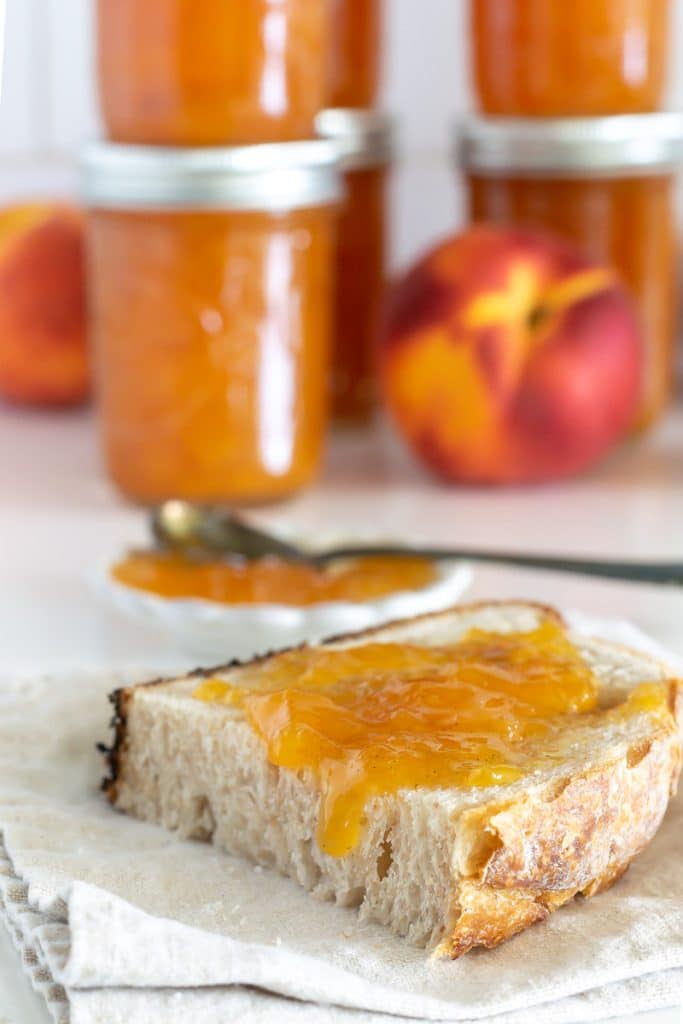
Can I Add Other Ingredients to This Recipe?
It depends! If you are freezing it, you could easily experiment. However, if you plan to water bath can the jelly to make it shelf stable, you need to be mindful of changing the pH. That being said, you could safely add vanilla pods or two tablespoons of vanilla extract.
You could also add cinnamon sticks or whole cloves to the maceration and cooking stage; make sure to remove them before canning. And consider adding 1/2 cup of your favorite brandy or rum to your peach preserves. Stir in the alcohol after you’ve determined that your preserves have set.
What’s the Difference Between Peach Preserves and Peach Jam?
The main difference between peach preserves and peach jam lies in the form and texture of the fruit used.
In preserves, the fruit comes in the form of large chunks or even whole fruit. The process of making peach preserves involves cooking the fruit with sugar until it gels, but the fruit retains much of its original shape. Preserves have a slightly more fruit-forward flavor and a chunkier texture than other forms of cooked fruit spreads.
The process of making Peach Jam involves cooking crushed or chopped peaches with sugar until they form a gel-like consistency. The fruit in jam is generally more broken down than in preserves, resulting in a smoother texture. Jams tend to be thicker and have a more uniform consistency than preserves.
Both peach preserves and peach jam offer a delicious way to enjoy the flavor of peaches, and the choice between them often comes down to personal preference in terms of texture and fruitiness. In recipes, they can usually be used interchangeably.
Water Bath Can or Refrigerate Your Preserves
Whether you water bath can or refrigerate/freeze your preserves is up to you.
Water bath canning is a method of preserving preserves, jams, and jellies to make them shelf-stable for up to two years. I walk you through the water bath canning process, but I HIGHLY RECOMMEND The All New Ball Book of Canning and Preserving if this is your first time making canned preserves.
To make your preserves shelf stable, all you need is an additional 30 minutes of your time, a water bath canner or pot deep enough to cover your jars by 2 inches, andjars suitable for water bath canning like these or Half-Pint Mason Jars with Self-Sealing Lids. A few more inexpensive pieces of equipment make your canning experience more enjoyable and efficient: a jar/can lifter, magnetic canning lid lifter, and headspace gauge itemized below.
If you’d rather refrigerate or freeze your preserves…
The only equipment you still need to prepare is your jars and lids. Just make sure that they are clean and freezer-stable jars. The best jars for freezing are those without shoulders, but instead are straight-sided. Mason jars are great jars to freeze preserves, jams, and jellies in.
Follow the directions as written, ignoring any references to preparing canning equipment. When you reach the directions to ladle the preserves into the jars, leave 1″ of headspace instead of 1/4″. Place lids on the jars and let them come to room temperature. Once they are at room temperature, you can refrigerate or freeze the jars. Your jars of preserves will keep in the freezer for 1 year and 1 month in the refrigerator.
Did You Catch The Canning Bug?
Want some more recipes to preserve summer’s bounty? You’ve come to the right place!
- This delicious Apricot Jam Recipe gets a little earthy kick from adding fresh thyme, which is optional if you just want a plain apricot jam. This recipe uses homemade apple pectin stock (recipe included) instead of commercial pectin.
- A recipe for Homemade Strawberry Rhubarb Jam that does not use added pectin but instead relies on apples to thicken the jam.
- Put a dollop of this rosy Rhubarb Jam on your morning toast, biscuit, or scones. Or add a swirl to your yogurt or ice cream.
- This No Pectin Blueberry Jam is subtly flavored with mellow and herby Chamomile tea.
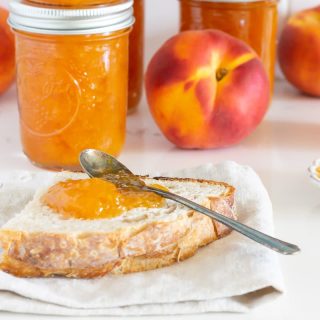
Peach Preserves
Equipment
Ingredients
- 5.5 pounds of ripe peaches approximately 15-20 peaches
- 6 cups granulated sugar
- 2 vanilla bean pods split (optional)
Instructions
- If you will be canning the jam, Prepare a canner, jars, and lids. Wash your jars and lids. Sterilize your jars in a large pot filled with water. Bring the water to almost a simmer over medium heat. Keep the jars in the simmering water over low heat until you are ready to fill them. Use a jar lifter to remove them from the water when you are ready to fill them, dumping the hot water back into the pot when you remove each jar from the water. Before you can, put your lids in a small pot or bowl with hot, but not boiling, water. Put some white vinegar in a small bowl alongside a clean washcloth or paper towel. Keep the water in your canning pot at a simmer while you fill your jars. See The All New Ball Book of Canning and Preserving for additional guidance.
- Put a small plate in the freezer.
- Wash and peel peaches. One option to peel peaches is to boil them for 30 seconds, then put them in an ice bath. This works especially well for ripe peaches but not so well for less-than-ripe peaches.
- Chop peaches and place them in a bowl.
- Add 6 cups sugar and stir well. If you are adding vanilla bean pods, add them now.
- Cover the bowl and refrigerate for at least 12 and up to 48 hours.
- After macerating, place peaches and syrup into a large, wide pot, jam pan, or preserving pan.
- Bring the fruit/sugar mixture slowly to a boil over medium heat. Stir frequently.
- Continue to boil gently for 30-40 minutes, until the peaches are clear and the syrup is thick. Stir frequently to prevent peach preserves from sticking to the bottom of the pan.
- Turn off the heat.
- Test for doneness. Remove the plate from the freezer and put a small dollop of preserves on the plate. Return it to the freezer for 2-3 minutes. Remove the plate from the freezer and run your finger through the jam. It is done if the trail your finger made is not immediately filled with preserves. Additionally, look for the preserves to ‘wrinkle.’
To Water Bath Process
- Spoon your preserves into hot sterilized half pint jars, leaving 1/4 inch headspace.
- Remove air bubbles and wipe the rim.
- Center lid on the jar
- Screw band down until resistance is met, then increase to fingertip tight.
- Place jars in a canner, ensuring there is at least 1" of water over the cans.
- Cover the pot and bring to a boil
- Boil for 10 minutes
- Turn the heat off, remove the lid, and let sit for 5 minutes
- Carefully remove jars with a jar lifter and place them on a rack to be undisturbed for 24 hours.
- Refrigerate any jars whose lids don't pop down.
To Freeze the Preserves
- Spoon preserves into clean jars, leaving 1-inch headspace.
- Remove air bubbles and wipe the rim.
- Center lid on the jar.
- Let cool to room temperature.
- Freeze jars.
Nutrition
Bookmark this page or pin the following image to refer back to this Peach Preserves Recipe in the future!
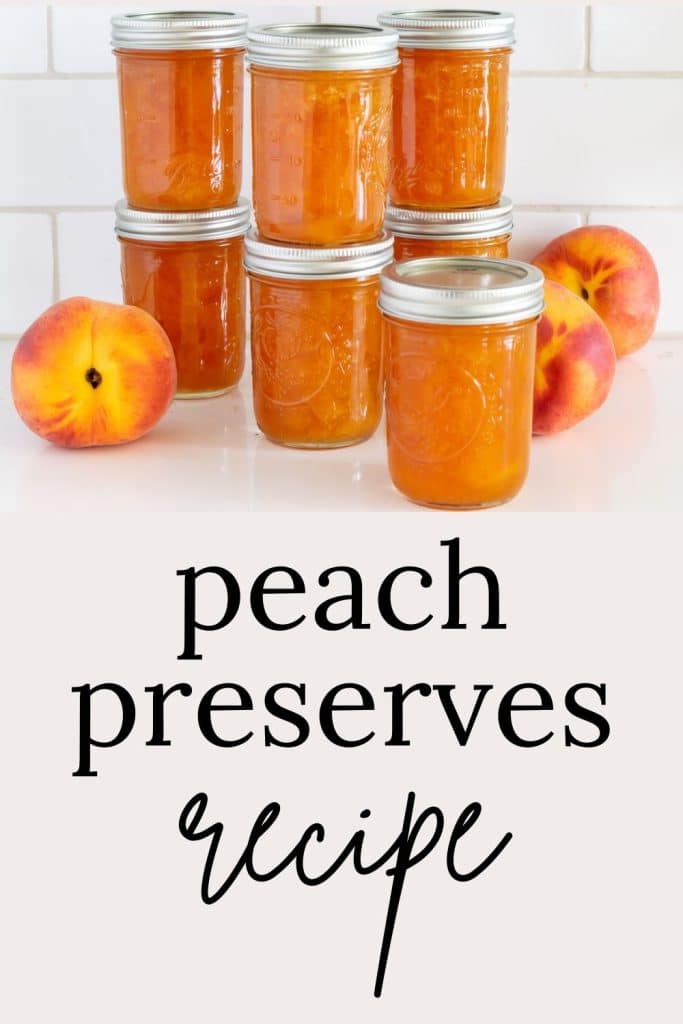
Thanks so much for spending a few minutes of your busy day with me!
To ensure you don’t miss future content, pop your email in the pale green box on the right or click here. I usually send one email weekly, so I won’t inundate your inbox. I’m sensitive to an overflowing email inbox!
We will only use your email address to send you emails, no more than 1-2 weekly. In addition, you will have access to my growing library of knit & crochet patterns and other printables. Check back often as this library will continue to grow. You can unsubscribe anytime by emailing me or clicking on the “unsubscribe” link at the bottom of all emails.
And you can access many of the products I refer to on my Nourish and Nestle Amazon Page. You can access it here.
So, if you’d like to participate in the ‘subscriber benefit’ action, simply subscribe to Nourish and Nestle here or use the form on the right sidebar. It’s slightly towards the top.
I have sent all my subscribers the link to the Subscriber Benefits Library. If you missed it or misplaced it, let me know.
Until next time…
Thanks so much for spending a few minutes of your busy day with me!
To ensure you don’t miss future content, pop your email in the pale green box on the right or click here. I usually send one email weekly, so I won’t inundate your inbox. I’m sensitive to an overflowing email inbox!
We will only use your email address to send you emails, no more than 1-2 weekly. In addition, you will have access to my growing library of knit & crochet patterns and other printables. Check back often as this library will continue to grow. You can unsubscribe anytime by emailing me or clicking on the “unsubscribe” link at the bottom of all emails.
And you can access many of the products I refer to on my Nourish and Nestle Amazon Page. You can access it here.
So, if you’d like to participate in the ‘subscriber benefit’ action, simply subscribe to Nourish and Nestle here or use the form on the right sidebar. It’s slightly towards the top.
I have sent all my subscribers the link to the Subscriber Benefits Library. If you missed it or misplaced it, let me know.
Until next time…



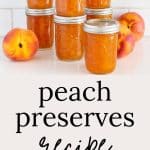
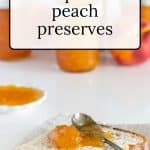

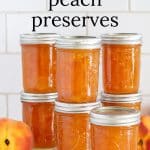
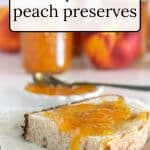

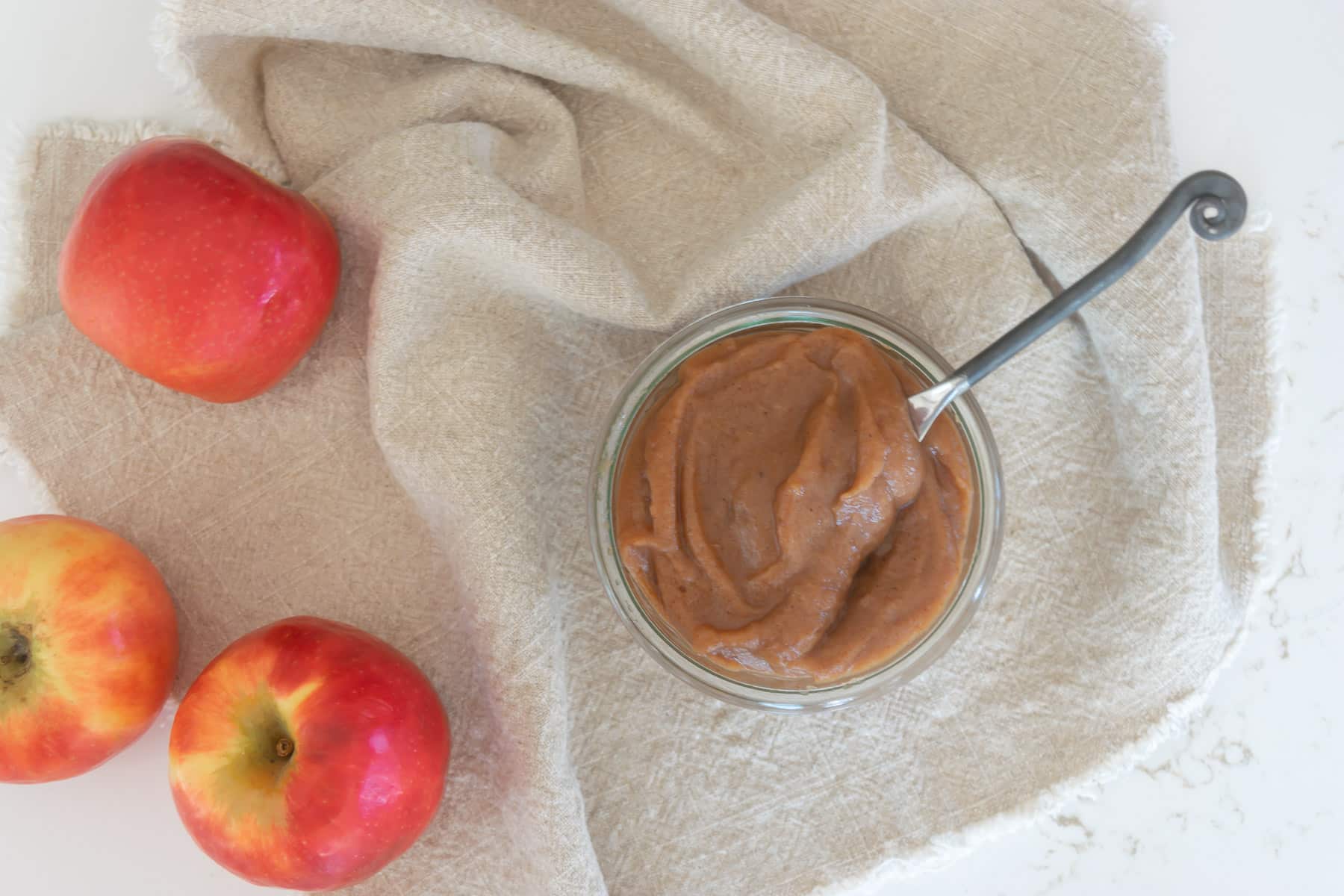
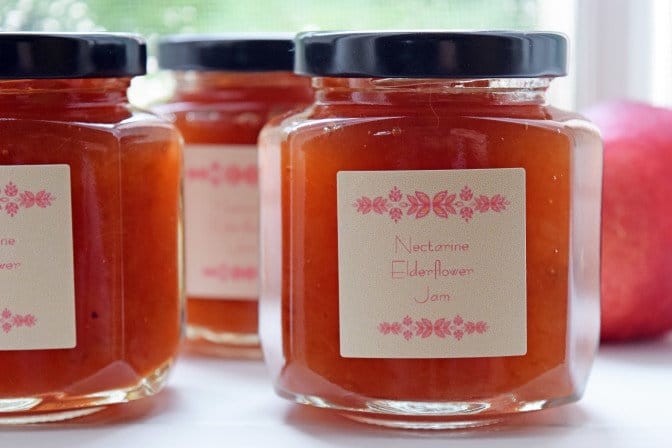
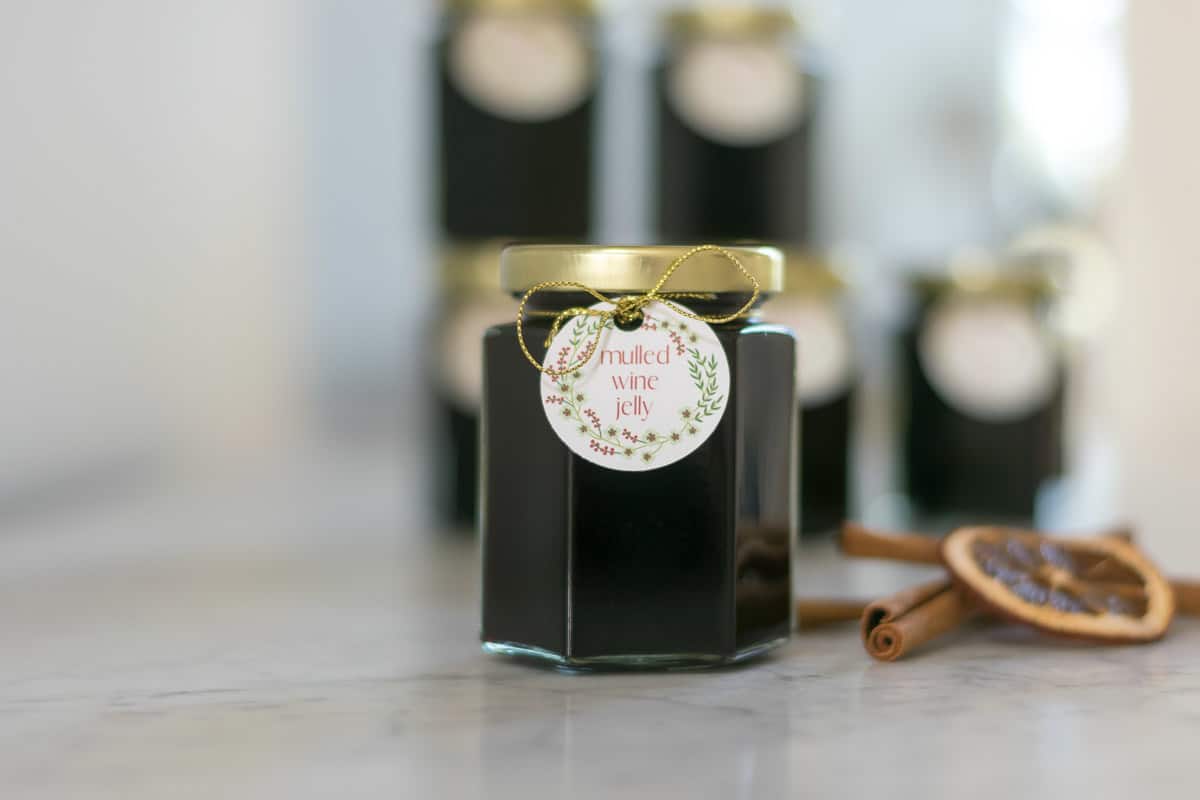
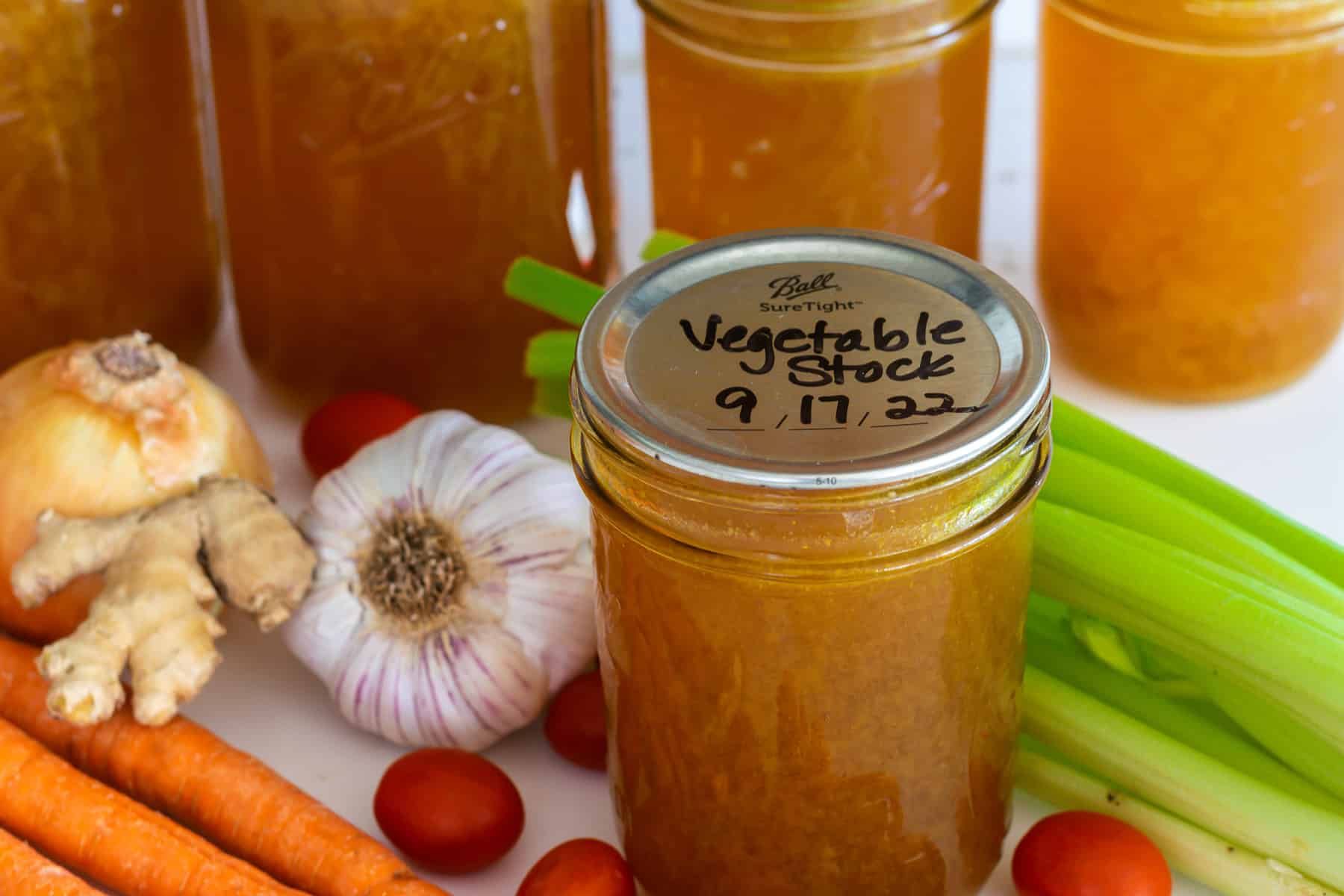
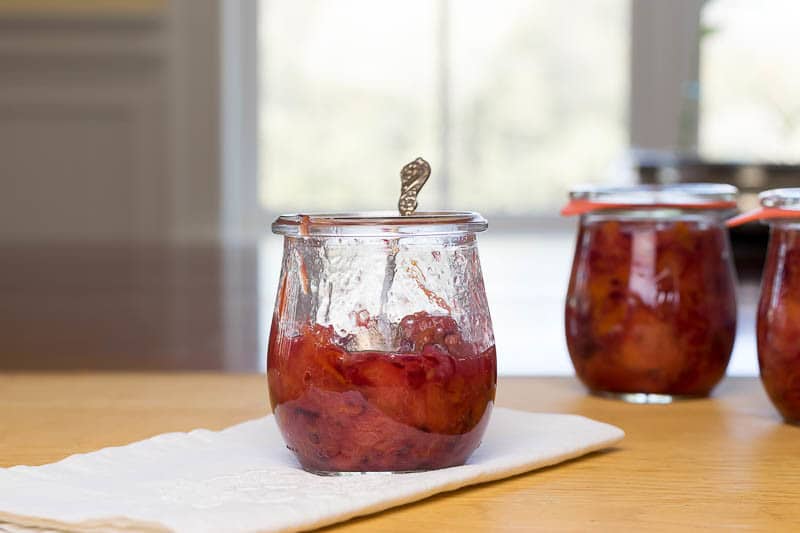
Hi Lynn,
We are eager to try your recipe but need clarification on peeling the peaches. You say “One option to peel peaches is to boil them for 30 minutes” – is this correct?
Thanks,
Sheila
Oh geez…no. It’s 30 seconds. I’ve corrected that…thanks for the heads up!